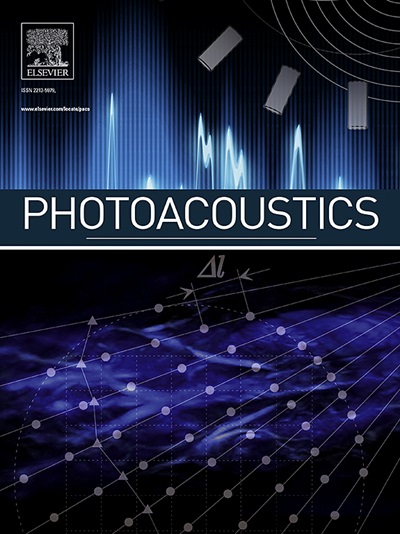Normal and melanoma skin visualized, quantified and compared by in vivo photoacoustic imaging
IF 6.8
1区 医学
Q1 ENGINEERING, BIOMEDICAL
引用次数: 0
Abstract
Photoacoustic imaging (PAI) shows promise for skin cancer diagnosis by detecting chromophores like melanin, hemoglobin, lipids, and collagen. While most studies focus on malignant lesions, understanding normal skin variability across anatomical regions is crucial for validating PAI's clinical application and its use in melanoma diagnosis. We assessed normal skin in 20 healthy volunteers from three different body locations using a clinical PAI system and compared suspicious looking pigmented skin lesions, including melanomas, to adjacent normal skin (n = 74). Higher deoxyhemoglobin levels were observed in the ankle compared to the cheek and volar forearm, while melanin, lipids, and collagen showed minimal variation. Patients with malignant lesions had significantly higher deoxyhemoglobin levels (p = 0.001) than adjacent normal skin, a difference not seen in benign lesions. These findings suggest that PAI may help diagnose malignancies by identifying increased vascularity in skin cancers, while anatomical differences should be considered during diagnostic work-up.
通过体内光声成像对正常皮肤和黑色素瘤皮肤进行可视化、量化和比较
光声成像(PAI)通过检测黑色素、血红蛋白、脂质和胶原蛋白等发色团,显示出皮肤癌诊断的希望。虽然大多数研究集中在恶性病变上,但了解正常皮肤解剖区域的变异性对于验证PAI的临床应用及其在黑色素瘤诊断中的应用至关重要。我们使用临床PAI系统评估了来自三个不同身体部位的20名健康志愿者的正常皮肤,并将可疑的色素皮肤病变(包括黑色素瘤)与邻近的正常皮肤进行了比较(n = 74)。与脸颊和前臂掌侧相比,在脚踝处观察到更高的脱氧血红蛋白水平,而黑色素、脂质和胶原蛋白的变化最小。恶性皮损患者的脱氧血红蛋白水平明显高于邻近正常皮肤(p = 0.001),而良性皮损患者没有这种差异。这些发现表明PAI可以通过识别皮肤癌中血管的增加来帮助诊断恶性肿瘤,而在诊断过程中应考虑解剖差异。
本文章由计算机程序翻译,如有差异,请以英文原文为准。
求助全文
约1分钟内获得全文
求助全文
来源期刊

Photoacoustics
Physics and Astronomy-Atomic and Molecular Physics, and Optics
CiteScore
11.40
自引率
16.50%
发文量
96
审稿时长
53 days
期刊介绍:
The open access Photoacoustics journal (PACS) aims to publish original research and review contributions in the field of photoacoustics-optoacoustics-thermoacoustics. This field utilizes acoustical and ultrasonic phenomena excited by electromagnetic radiation for the detection, visualization, and characterization of various materials and biological tissues, including living organisms.
Recent advancements in laser technologies, ultrasound detection approaches, inverse theory, and fast reconstruction algorithms have greatly supported the rapid progress in this field. The unique contrast provided by molecular absorption in photoacoustic-optoacoustic-thermoacoustic methods has allowed for addressing unmet biological and medical needs such as pre-clinical research, clinical imaging of vasculature, tissue and disease physiology, drug efficacy, surgery guidance, and therapy monitoring.
Applications of this field encompass a wide range of medical imaging and sensing applications, including cancer, vascular diseases, brain neurophysiology, ophthalmology, and diabetes. Moreover, photoacoustics-optoacoustics-thermoacoustics is a multidisciplinary field, with contributions from chemistry and nanotechnology, where novel materials such as biodegradable nanoparticles, organic dyes, targeted agents, theranostic probes, and genetically expressed markers are being actively developed.
These advanced materials have significantly improved the signal-to-noise ratio and tissue contrast in photoacoustic methods.
 求助内容:
求助内容: 应助结果提醒方式:
应助结果提醒方式:


